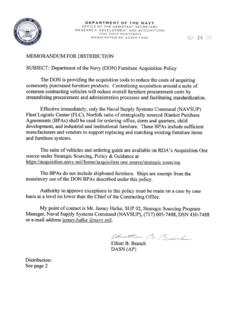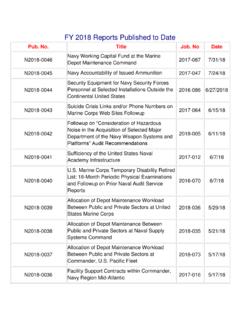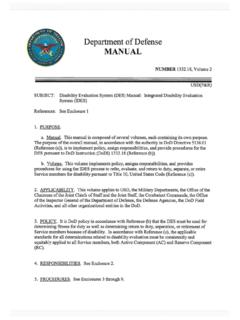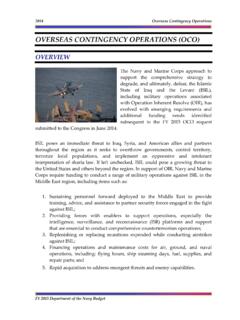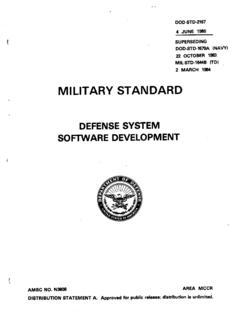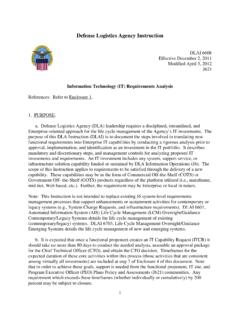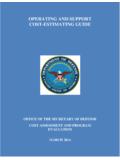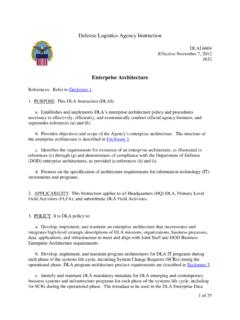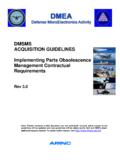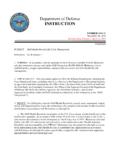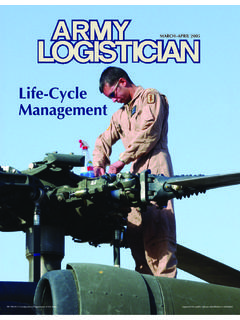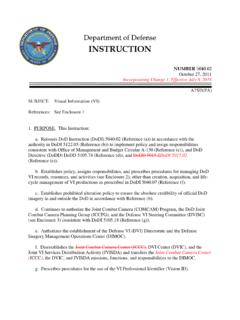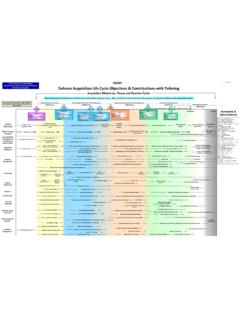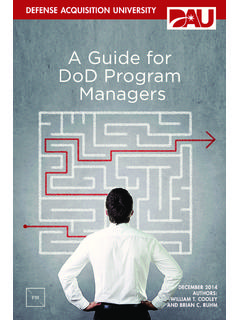Transcription of Designing and Assessing Supportability in DOD Weapon …
1 Designing and Assessing Supportability in DOD Weapon Systems: A Guide to Increased Reliability and Reduced Logistics Footprint Prepared by the Office of Secretary of Defense October 24, 2003. 1. Designing and Assessing Supportability in DOD Weapon Systems: A Guide to Increased Reliability and Reduced Logistics Footprint Table of Contents EXECUTIVE SUMMARY .. 3. 1. DEFENSE ACQUISITION management FRAMEWORK AND A GUIDE TO. INCREASED RELIABILITY AND REDUCED LOGISTICS FOOTPRINT .. 4. 2. SYSTEM DESIGN THROUGH APPLICATION OF THE SOE CONCEPT.
2 7. System Operational Effectiveness: Design for Support' and Support the Design' .. 8. System Operational Effectiveness: Balancing Variables and Making 9. System Performance .. 11. System Availability .. 11. Process Efficiency .. 14. Technical Effectiveness .. 15. System Effectiveness.. 16. System Ownership Cost/Cost-As-An-Independent 16. Operational Effectiveness .. 16. The SOE Model and the Defense Acquisition management 16. 3. Supportability ASSESSMENT THROUGHOUT THE life cycle .. 18. Introduction .. 18. Pre-Acquisition Phase.
3 18. Definition of System Operational Effectiveness Components in the Pre- Acquisition 20. Concept Refinement Phase and Milestone A - Technology Development Phase .. 21. Risk Considerations During Pre-Acquisition .. 24. Milestone B - System Development and Demonstration Phase .. 25. Milestone C - Production and Deployment Phase .. 28. Post-IOC Evolution of Sustainment Strategies .. 31. Post Deployment 31. Post Deployment System Modifications .. 32. Assessing and Revising Product Support 33. SUMMARY .. 34. 2. EXECUTIVE SUMMARY. The challenges facing today's program manager (PM) have increased dramatically.
4 The 2001 Quadrennial Defense Review (QDR) described the need to reduce the logistics footprint, improve our global mobility, and increase reliability of DoD Weapon systems. The new DoD. and are oriented toward achieving these objectives while also reducing the time required for development and deployment of needed warfighter capability through implementation of evolutionary acquisition strategies and spiral development processes. Another fundamental change in DoD policy is the designation of the Weapon system PM as the life cycle manager [Total life cycle Systems management (TLCSM)], responsible not only for effective and timely acquisition of the system, but also for service as the primary manager and single point of accountability for sustainment of a Weapon system throughout its life cycle .
5 This guide provides a template for PMs when assigned or responsible activities to use in defining and Assessing their program activities to meet QDR objectives and DoD policy requirements throughout the Weapon system life cycle . Emphasis is placed on Designing for increased reliability and reduced logistics footprint and on providing for effective product support through performance-based logistics (PBL) strategies. The guide uses the Defense Acquisition management Framework and a systems engineering process to define the appropriate activities and required outputs throughout a Weapon system's life cycle to include those related to sustainment of fielded systems.
6 A System Operational Effectiveness (SOE) framework is included that shows the linkage between overall operational effectiveness and Weapon system and product support performance. With today's use of evolutionary acquisition, there is a diminution of the sequential, chronologically phased sequence of design, development, deployment and sustainment activities. With an incremental block development approach, the PM may be involved in one or more of these activities simultaneously. The PM also has to contend with the increasing emphasis on system of systems concepts and network centric warfare.
7 Clearly, there is a need for facilitating guidance to assist the PM with the increasing complexities of that role. This guide provides a reference for PMs and their teams to design in and then assess the effectiveness of their TLCSM responsibilities in implementing PBL strategies anywhere along the system's life cycle . OSD Point of Contact: Academic Point of Contact: Industry Point of Contact: Mr. Jerry Beck Dr. Dinesh Verma Mr. Tom Parry OADUSD Stevens Institute of Technology Decisive Analytics Corporation 3. 1. DEFENSE ACQUISITION management FRAMEWORK AND A GUIDE TO.
8 INCREASED RELIABILITY AND REDUCED LOGISTICS FOOTPRINT. Revised policy with specific relevance to Supportability is found in DoD Directive (Defense Acquisition System) and DoD Instruction (Operation of the Defense Acquisition System). This policy provides a clear rationale for the design and assessment of Supportability in DoD Weapon systems throughout the life cycle . The policy clearly establishes that: The PM is the single point of accountability: Each PM is charged with the accomplishment of program objectives for the total life cycle , including sustainment.
9 Evolutionary acquisition: This is DoD's preferred strategy for satisfying operational needs. Spiral development and incremental development are the two basic approaches for achieving evolutionary acquisition. Supportability and Sustainment as key elements of performance: Supportability and sustainment are essential components of battlefield effectiveness. If a Weapon system is not supportable and sustainable, it cannot be considered as an effective warfighting capability. Performance-based strategies: For the acquisition and sustainment of products and services, performance-based strategies will be considered and used whenever practical.
10 This approach applies to new procurements, major modifications and upgrades, as well as to re-procurements. Performance Based Logistics (PBL) strategies: PBL is the preferred support strategy within the Department of Defense whenever practical, and PMs are to work directly with users to develop and implement PBL agreements. Increased reliability and reduced logistics footprint: PMs must ensure the application of a robust systems engineering process to provide for reliable systems with reduced logistics footprint and total ownership cost (TOC).


